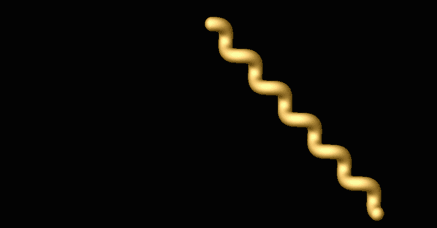UC Berkeley Press Release
 This cartoon animation shows how the spiroplasma propagates a kink by winding itself between two different helices. (Images courtesy of Joshua W. Shaevitz/UC Berkeley) |
Researchers reveal twists and turns of Spiroplasma bacteria's movements
BERKELEY – What does a telephone cord have in common with a bacterium? Researchers at the University of California, Berkeley, have discovered that the movements of Spiroplasma, tiny helical bacteria that infect plants and insects, resemble a kink moving down a spiral phone cord.
The findings, published in the Sept. 23 issue of the journal Cell, describe for the first time a new form of movement for bacteria. The researchers said that understanding how bacteria move from one point to another is important in disease control.

Doin' the twist
Video of Spiroplasma swimming, taken at 100x magnification. The cell is roughly 4 microns long (about 1/7000 of an inch)
(96Kb AVI file)
The researchers noted that Spiroplasma are particularly difficult to attack because, like other bacteria of the class Mollicute, they lack a cell wall, which many types of antibiotics target.
Study co-author Joanna Lee, a third-year undergraduate student in plant and microbial biology, pointed out that Spiroplasma cause millions of dollars in damage to California's agricultural industry each year. "There's no real treatment to prevent infection by Spiroplasma kunkelii, which is spread by the corn leafhopper insect and causes corn stunt disease, a major agricultural problem which occurs from the southern United States all the way to Brazil and Peru," said Lee. "Spiroplasma also stunt the growth of citrus crops, including oranges. The more we find out about these bacteria, the greater our chances of finding a way to stop them."
Prior to this study, the researchers said, the only well-understood method for bacterial propulsion was the one that involves the use of flagella, tails that use a propeller-like motion to move the organism forward. One of the most studied bacteria, Escherichia coli, use flagella to swim about.
"For a long time, swimming with these tail-like appendages has been the best understood form of bacterial motility," said Daniel Fletcher, UC Berkeley assistant professor of bioengineering and principal investigator of this research. "But as one of the smallest-known bacteria, Spiroplasma don't have flagella. Their bodies are only a few microns long, and about 150 nanometers wide, so there isn't a lot of room for a tail. Instead, these organisms developed an alternate way to get around."
Using high-resolution video microscopy, the UC Berkeley researchers recorded movies of the Spiroplasma bacteria swimming, and, using a computer, analyzed what their helical bodies did during swimming as well as calculated how fast they moved. They discovered that Spiroplasma swim by propagating a pair of large kinks down the axis of their bodies. The movement generates enough thrust to push the cell body forward.
"If you take a phone cord and unwind one part of it so that you have a junction between a left-handed and a right-handed helix, there is a natural kink that forms," said Shaevitz. "We show that Spiroplasma form their kinks in the same way, by unwinding their bodies from a right-handed helix to a left-handed one and back again."
Using this motion, Spiroplasma can scoot themselves along in a zigzag pattern at a rate of 5-10 microns, approximately a body length, every second. The Spiroplasma moved fastest in a medium containing methylcellulose, a viscous solution with a mesh-like network from which the bacteria can "push off," the researchers said. This environment is similar to the biological tissue of insects and plants infected by Spiroplasma.
Moreover, the researchers believe that the movements are generated internally by the Spiroplasma's cytoskeletal filaments.
"There is nothing on the outside of the Spiroplasma to account for their movement," said Fletcher. "While the primary function of filaments inside the bacteria is to form the shape of the organism, this study provides strong evidence that the filaments have another role, that of generating movement."
The research was supported by the Miller Institute for Basic Research in Science and the National Science Foundation.

